|
- Integrated Packages
- Gigabyte Networks
- Trouble Shooting
- Wireless Technology
- On a Budget
- Dot Net Business |
Windows XP Internet Connection
Firewall
Windows XP's Internet Connection
Firewall (ICF) protects your network against undesired incoming
traffic from the Internet -- everything from casual port scans
by bored teenagers to serious break-in attempts by determined
hackers. ICF creates a protective barrier between your network
and the Internet, only passing through traffic that you've
requested.
You can enable or disable ICF separately on each dial-up, LAN,
or high-speed Internet connection in the Network Connections
folder. That's good, because there are some connections that can
benefit from ICF, and some that must not use it.
Here are some points to ponder when deciding whether to use ICF
on your network connections.
WARNING #1: As its name implies, the Internet Connection
Firewall is for use ONLY on a direct connection to the Internet,
such as a dial-up, DSL, or cable modem. If your computer gets
its Internet connection through a software router (like Internet
Connection Sharing) or a hardware router, you don't have a
direct connection and must not enable ICF.
WARNING #2: If the Internet Connection Firewall is
enabled on a local area network connection with other computers,
it will block File and Printer Sharing. This is probably the
most common problem in Windows XP networking.
WARNING #3: ICF is only effective against undesired
incoming traffic from the Internet. It can't stop undesired
outgoing traffic from spyware, Trojan horse programs, or other
hacker tools. If you want outgoing protection, use a firewall
that offers that capability, and disable ICF on all connections.
WARNING #4: To enable or disable ICF, you must be logged
on as a user that is a member of the Administrators group.
Enabling and Disabling the
Internet Connection Firewall
To enable ICF on an Internet
connection, open the Network Connections folder, right click the
desired connection, and click Properties.
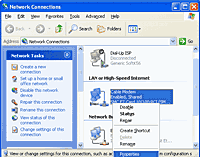
The Properties sheet shows the network components associated
with the connection.
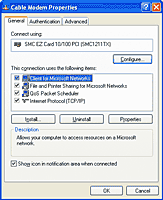
Click the Advanced tab, then check Protect my computer and
network by limiting or preventing access to this computer from
the Internet.
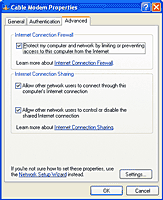
If the firewall is enabled and you want to disable it, un-check
the same box.
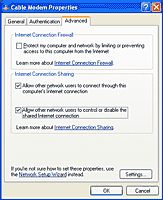
Windows XP asks you to confirm your decision to disable the
firewall. Click Yes to disable it.
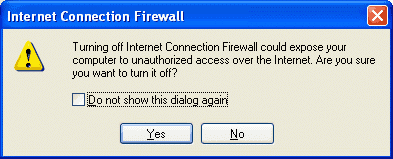
Internet Connection Firewall Security Log
By default, ICF silently discards all undesired incoming
traffic. To see a record of its activity, you can enable
security logging.
Open the Advanced tab of the network connection's properties and
click Settings.

Click Security Logging to bring up the logging options.

To see messages about discarded traffic, check Log dropped
packets. On a cable modem connection, it's common to see several
dozen of these messages every day.
To see messages about permitted traffic, check Log successful
connections. Selecting this option can cause the log file to
grow very large very quickly. To limit its size, enter a number
in the Size limit box.
By default, the security log is written to file pfirewall.log in
the Windows folder. To change the file name, enter a new name in
the Name box, or click the Browse button and browse to the new
file.
For information on how to read and interpret the security log,
click Learn more about Internet Connection Firewall on the
Advanced tab.
click here to go back
|